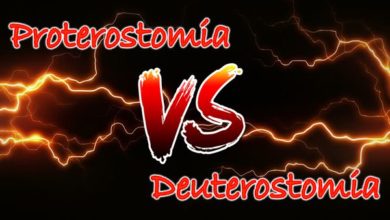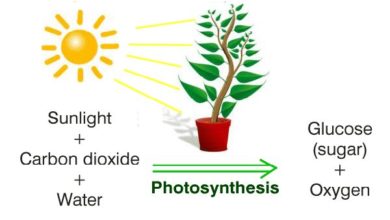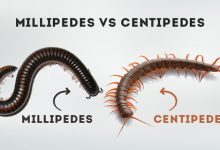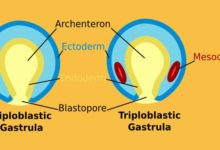DNA and RNA are two types of nucleic acid. The polymers of nucleotides are called nucleic acids. The unit of nucleic acid is a nucleotide. Nucleic acids are special compounds, produced in the nucleus of the cell. These are composed of Carbon, hydrogen, Oxygen, Nitrogen, and Phosphorus.
Discovery of Nucleic Acids
F. Miescher isolated the nucleic acid from the nucleus of pus cells in 1870. As they were isolated from the nucleus and were acidic in nature, so they were named nucleic acid.
Types of nucleic acid
There are two types of nucleic acids:
- DNA
- RNA
DNA (deoxyribonucleic acid)
DNA is present in chromosomes, in the nucleus of cells. A small amount of DNA is also present in mitochondria and chloroplast.
RNA (ribonucleic acid)
RNA is present in the nucleolus, ribosome, and cytosol of the cytoplasm. A small amount of RNA is also present in other parts of the cell.
Structure of Nucleic Acid
Nucleic acids are complex substances. They are polymers of units called nucleotides. DNA is composed of deoxyribonucleotides and RNA is composed of ribonucleotides.
Nucleotides (nitrogen base + pentose sugar + phosphoric acid)
Each nucleotide is made up of three subunits pentose sugar, nitrogen base, and phosphoric acid.
Pentose Sugar
It is a five-carbon monosaccharide. The nucleotides of RNA contain ribose sugar. On the other hand, the nucleotides of DNA contain Deoxyribose sugar.
Nitrogen Base
Nitrogen bases are of two types.
- Pyrimidines: These are composed of a single ring. These are Cytosine (C), Thymine (T), and Uracil (U).
- Purines: These are composed of double rings. These are Adenine (A) and Guanine (G).
Phosphoric Acid
It has the ability to form an ester linkage with the OH group of Pentose Sugar. The nitrogen base is attached to carbon 1 of the pentose sugar in a typical nucleotide. The phosphoric acid is attached with carbon 3 of the pentose sugar. ATP (adenosine triphosphate) is also an important nucleotide. The cells use ATP as energy currency.
Nucleoside (Nitrogen Base + Pentose Sugar)
The compound formed by the nitrogenous base and pentose sugar is called nucleoside. A nucleoside and phosphoric acid combine to form a nucleotide.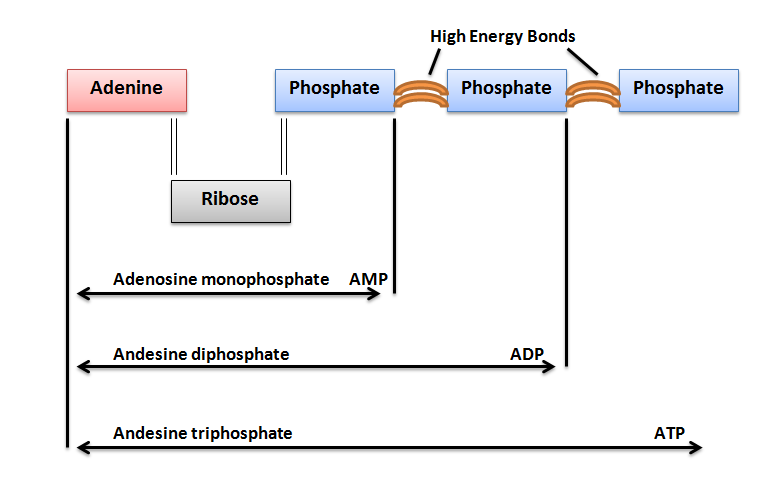
DNA (deoxyribonucleic acid)
DNA is the hereditary material. It controls the properties and activities of a cell.
Components of DNA
DNA is made of four kinds of Nucleotides. These are:
- d-adenosine monophosphate (d-AMP).
- d-guanosine monophosphate (d-GMP).
- d-cytidine monophosphate (d-CMP).
- d-thymidine monophosphate (d-TMP).
The nucleotides are linked with one another by phosphodiester bonds and form a long chain. This chain is called Polynucleotide chain. This chain has a specific sequence. There may be different lengths of nucleotide chains.
Dinucleotide
Two nucleotides join to form dinucleotide. Nicotinamide adenine dinucleotide (NAD) is a dinucleotide. It is an important coenzyme. It takes part in several oxidation-reduction reactions in the cell.
Trinucleotides
Three nucleotides join to form Trinucleotides.
Polynucleotides
Many nucleotides join to form polynucleotides.
The ratio of bases in DNA
Erwin Chargaff provided data about the ratio of different bases of DNA molecules. It shows that adenine and Thymine have equal ratios and guanine and cytosine have equal ratios.
Watson and Crick model of DNA
Maurice Wilkins and Rosalind Franklin determine the structure of DNA by X-ray diffraction technique. Finally, James D. Watson and Francis Crick proposed the model of DNA. It suggests:
- The DNA is made up of two polynucleotide chains or strands.
- These two strands coil around each other and form a double helix.
- The coiling of the two strands is opposite (antiparallel to each other i.e., one strand is 3-5 the other is 5-3).
- The two strands are attached to each other by weak hydrogen bonds. Two hydrogen bonds are formed between A and T and three hydrogen bonds are formed between G and C pairs.
- Adenine (A) is always opposite to Thymine (T) and Guanine (G) is always opposite to Cytosine.
- The two strands coil around each other. Each turn of the strands is about 34 Angstrom. This turn contains 10 base pairs.
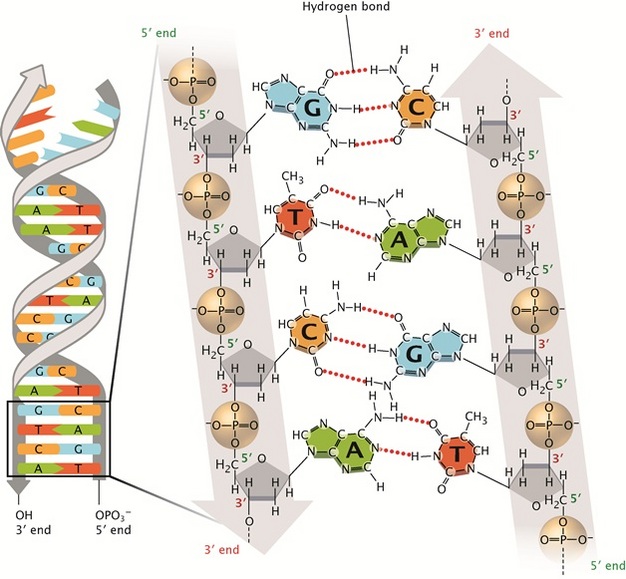
Amount of DNA in different Species
The amount of DNA depends on the number of chromosomes in a species. Each species has a fixed number of chromosomes. So the amount of DNA is also fixed for a particular species. The germ cells (sperm and ova) contain one-half the amounts of the somatic cells (body cells).

Importance of DNA
All the information for the structure and the functioning of a cell are stored in DNA. For example, E.coli (bacteria) contains a single chromosome. This chromosome contains 5 million bases. These bases are arranged in a particular linear order. These bases contain information. This information is present in the form of units called “genes”. A gene is a small part of DNA that controls a specific character. Gene is a unit of biological inheritance.
The E.coli genome (total number of genes) consists of 4, 639, 221 base pairs. This genome codes for 4288 proteins.
Haemophilus influenza (a bacteria that causes influenza is the first microbe that genome has been completely sequenced. This sequencing was published in 1995).
DNA as Hereditary Material:
DNA is found in genes and chromosomes. It is considered genetic material because it transfers the hereditary character into a new cell or a new generation. The property of DNA as hereditary material can be proved by two experiments:
Griffith Experiment:
Griffith proved DNA as genetic material by the transformation process in bacteria. In this process, the living bacteria can get genetic material (DNA) from dead bacteria and can be transformed (changed) from harmless to harmful virulent bacteria. It shows that DNA acts as genetic material.
Hershey and Chase Experiment:
Hershey and Chase presented another proof of DNA as genetic material. According to their experiment, it is proved that the genetic material (DNA) of one bacterial cell can be transferred into another bacterial cell by bacteriophage virus.
They explained that when bacteriophage virus attacks bacterial cells only its DNA enters the bacterial cell and its outer protein coat remains outside. The DNA of the virus takes the biochemical control of bacterial cells and starts to prepare its DNA. After that, the complete body of the virus is formed. It indicates that DNA acts as genetic material.
Function of DNA
The four nitrogen bases of DNA take part in the genetic code. These are arranged in a straight manner along the DNA strand. In plants and animals, numerous information can be encoded in the form of genetic code.
